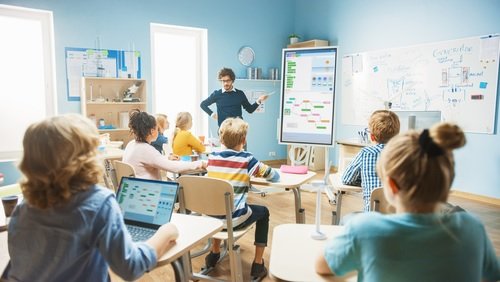Key Takeaways:
- Diverse learning methods contribute to better educational outcomes.
- Technology plays a crucial role in modern learning environments.
- Collaborating with educators can enhance the learning experience.
Understanding Diverse Learning Methods
In today’s rapidly evolving educational environment, recognizing and embracing diverse learning methods has become a fundamental aspect of effective teaching. Education is no longer about a one-size-fits-all approach. Each student has a distinctive visual, auditory, or kinesthetic learning preference. By adopting these varied pedagogies, schools don’t merely engage their students more effectively; they also elevate the overall learning outcome. This approach ensures that all students, irrespective of their preferred learning style, have the opportunity to succeed.
The Role of Technology in Education
Integrating technology into the educational sphere transforms how information is delivered and consumed. Technology has reinvented traditional teaching methods with the advent of e-learning platforms, digital classrooms, and interactive tools. Schools and universities across the globe are leveraging these technological advancements to create more interactive and personalized learning experiences. The success stories of institutions that have seamlessly integrated technology into their curricula serve as beacons for others aspiring to do the same. While the benefits of incorporating technology are apparent, challenges such as digital distractions and unequal access to resources pose significant hurdles. Schools must balance embracing innovation and addressing these challenges to maximize these technological opportunities. Institutions offering programs such as the Doctor of Education Online underscore the significance of adapting teaching techniques to foster inclusive and effective educational practices.
Active Learning and Student Engagement
Active learning represents a dynamic shift in educational approaches, focusing on student involvement rather than the passive reception of information. By implementing strategies such as discussion groups, peer collaboration, and problem-based learning, students transition from observers to active participants in their educational journeys. This shift significantly enhances engagement, comprehension, and retention. This intrinsic variety requires educators to design their teaching strategies to accommodate different multiple intelligences and learning styles, crafting learning experiences that resonate with every student. According to research, active learning environments nurture deeper understanding and critical thinking skills among students, making them more adept at applying knowledge to real-world situations. Educators increasingly employ these active learning techniques to foster a classroom atmosphere that prevails excitement and curiosity. This hands-on approach creates opportunities for students to engage with their peers, share perspectives, and develop collaborative problem-solving skills, preparing them for future academic and career challenges.
Collaboration Between Educators and Students
Collaboration between educators and students is a critical component of effective education. It involves more than just communicating knowledge; it’s about building learning partnerships that empower students and enhance their educational experiences. By fostering open lines of communication and encouraging student feedback, educators can tailor their teaching approaches to meet the needs of their students better. This collaborative dynamic promotes a more personalized and meaningful learning experience, increasing student motivation and achievement. Additionally, involving students in decision-making processes regarding their learning fosters a sense of ownership and responsibility. Real-world examples illustrate the profound impact of successful educator-student partnerships, where students feel valued and supported, leading to remarkable academic achievements and personal growth. Such partnerships enable educators to address individual learning needs while cultivating an inclusive and supportive classroom environment.
Evaluation and Feedback for Continuous Improvement
Regular evaluation and feedback are essential in the learning process, serving both students and educators. Continuous assessments allow educators to monitor student progress, identify areas for improvement, and adjust instructional strategies accordingly. When clear and constructive, feedback can guide students toward refining their skills and enhancing their understanding of the subject matter. Promoting self-directed learning and nurturing a growth mindset is enhanced by engaging students in critical reflection on their progress. Integrating technology into the feedback process can streamline communication, making it easier for students to access resources that support their learning goals. Implementing formative assessments, peer reviews, and reflective activities in the classroom ensures that feedback is both actionable and meaningful. This continuous improvement empowers students to take ownership of their learning journey, resulting in more engaged and motivated learners.
Developing Critical Thinking Skills in Students
In an era of information overload, developing critical thinking skills is more important than ever for students. Critical thinking empowers students to analyze, evaluate, and synthesize information, equipping them with the ability to make informed decisions. Educators can foster these skills by incorporating inquiry-based learning approaches, encouraging students to question assumptions, explore alternatives, and reason logically. Collaborative group projects can also enhance critical thinking by allowing students to constructively engage with diverse perspectives and challenge each other’s ideas. Schools and programs prioritizing essential exercises of thinking create better-equipped students to tackle complex problems and succeed academically and professionally. These skills are indispensable in preparing students to navigate the intricate challenges of the modern world, encouraging them to think independently and innovatively.
Adapting to Change in the Educational Landscape
The educational landscape is constantly in flux, propelled by technological advancements, societal shifts, and evolving student needs. To remain effective, educators must be flexible, adaptable, and committed to continuous professional development. Staying abreast of emerging teaching methodologies and tools is vital for educators to deliver high-quality education. However, overcoming resistance to change among educators and students is a common challenge. Facilitating professional development workshops focused on innovative practices can empower educators to embrace new approaches confidently. Cultivating a culture of continuous learning and adaptability is critical to embracing these changes. By fostering an environment that encourages innovation and openness to new ideas, educators can better prepare students for an ever-changing future, ensuring that learning remains relevant and impactful.








